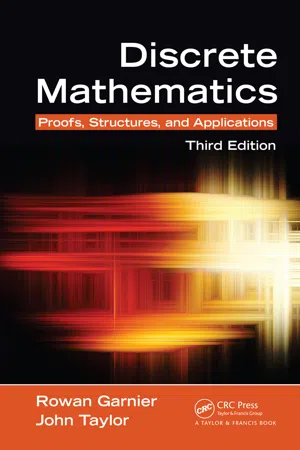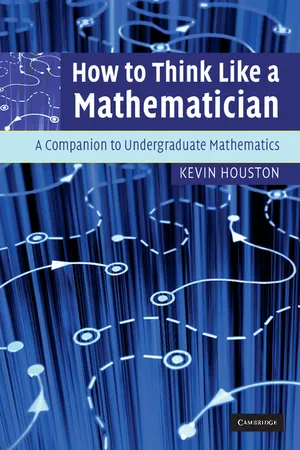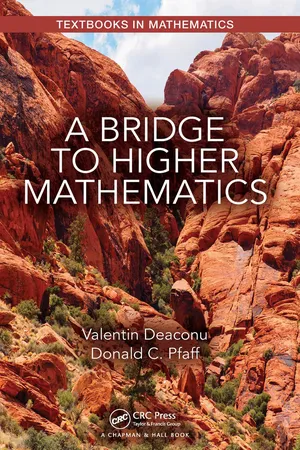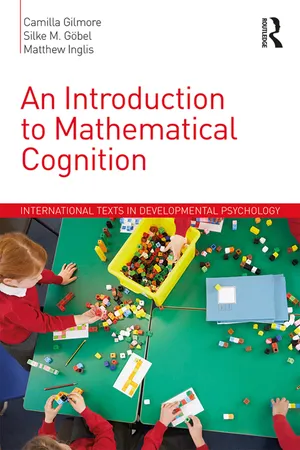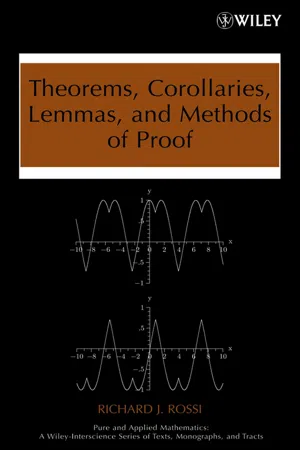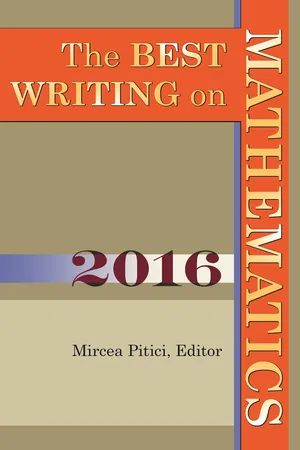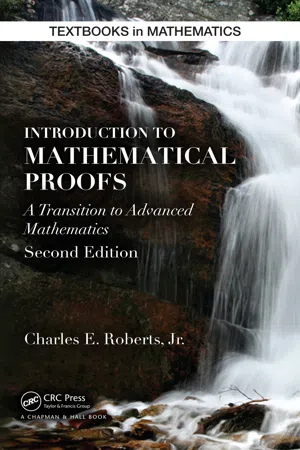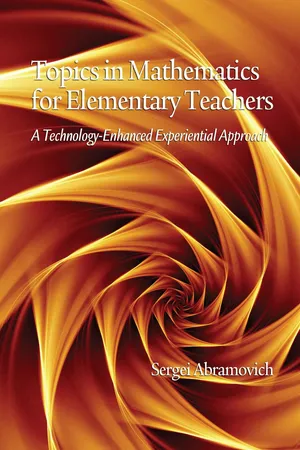Mathematics
Proof
In mathematics, a proof is a logical argument that demonstrates the truth of a statement or theorem. It typically involves a series of steps that follow established rules of logic and reasoning, leading to a clear and irrefutable conclusion. Proofs are essential in establishing the validity of mathematical results and are a fundamental aspect of mathematical reasoning and understanding.
Written by Perlego with AI-assistance
Related key terms
1 of 5
10 Key excerpts on "Proof"
- eBook - PDF
Discrete Mathematics
Proofs, Structures and Applications, Third Edition
- Rowan Garnier, John Taylor(Authors)
- 2009(Publication Date)
- CRC Press(Publisher)
Chapter 2 Mathematical Proof 2.1 The Nature of Proof The discipline of mathematics is characterized by the concept of Proof. In this chapter we consider the nature of mathematical Proof, some of the different techniques of Proof and how a Proof should be constructed and written down. What do mathematicians mean by ‘Proof’? The popular view of a mathematical Proof is probably that of a sequence of steps, almost certainly written mainly in symbols, where each step follows logically from an earlier part of the Proof and where the last line is the statement being proved. Associated with this image is probably the notion that a Proof is the absolute and rigorous test of mathematical truth. Surprisingly perhaps, this is not quite the view of many mathematicians, although there is by no means unanimity of opinion amongst the mathematical professionals themselves. Many hold a more sociological view of the role of a Proof. They see it as essentially an explanation and communication of ideas; a line of argument sufficient to convince a fellow mathematician of the validity of the particular result. As the great English mathematician Godfrey Hardy wrote: ‘Strictly speaking there is no such thing as mathematical Proof; . . . [they are] rhetorical flourishes designed to affect psychology, . . . devices to stimulate the imagination of students.’ Which, then, is the ‘correct’ view of the nature and significance of the Proof of a mathematical theorem? Probably the best answer is: both! The word ‘Proof’ is used to cover a wide spectrum of styles. At one extreme we have very formal Proofs which are rather like the logical arguments considered in chapter 1. Each step follows from the premises or a previous step by the laws of logic. Indeed, it is possible to write out such a Proof using only symbols and no words but, needless 50 Axioms and Axiom Systems 51 to say, this is likely to be very difficult to follow. - eBook - PDF
How to Think Like a Mathematician
A Companion to Undergraduate Mathematics
- Kevin Houston(Author)
- 2009(Publication Date)
- Cambridge University Press(Publisher)
The truth is determined and justified with a mathematical Proof. What is a Proof? A Proof is an explanation of why a statement is true. More properly it is a convincing explanation of why the statement is true. By convincing I mean that it is convincing to a mathematician. (What that means is an important philosophical point which I am not going to get into; my interest is more in practical matters.) Statements are usually proved by starting with some obvious statements, and proceeding by using small logical steps and applying definitions, axioms and previously established statements until the required statement results. The mathematician’s concept of Proof is different to everyday usage. In everyday usage or in court for instance, Proof is evidence that something is likely to be true. Mathematicians require more than this. We like to be 100% confident that a statement has been proved. We do not like to be ‘almost certain’. Having said that, how confident can we be that a theorem has been proved? Millions have seen a Proof of Pythagoras’ Theorem; we can be certain it is true. Proofs of newer results, however, may contain mistakes. I know from my own experience that some Proofs given in books and research journals are in fact wrong. Why prove statements? In other subjects most statements are open to debate and whether you believe a particular one may be down to personal tastes or prejudices. The existence of Proofs means this is 116 Proofs are hard to create – but there is hope 117 not so in mathematics and is a major reason for using them. The great advantage is that you can assess the truth of a statement by studying its Proof. By proving statements we can build mathematics, one statement on top of another. This gives real power to mathematicians. It allows us to be confident and advance. Philosophers, for example, are still arguing about the same questions that the ancient Greeks wrestled with. - eBook - PDF
- Valentin Deaconu, Donald C. Pfaff(Authors)
- 2016(Publication Date)
- Chapman and Hall/CRC(Publisher)
The typical daily project in mathematics is to discover a consequence of one or more hypotheses and, hopefully, to prove it. In practice, that’s what mathematics is all about. In this chapter, we discuss different methods of Proofs, illustrating the rules of logic that we have learned in the previous chapter. We begin with the concepts of axiom, theorem, Proof, and conjecture. We will discuss several examples of direct Proofs, indirect Proofs, and Proofs by contradiction. We also illustrate Proofs by cases, existence Proofs, Proofs by counterexample, and Proofs by mathematical induction. More examples of Proofs will appear in the subsequent chapters, after new concepts are introduced. 15 16 A bridge to higher mathematics 2.1 Axioms, theorems and Proofs In constructing a mathematical theory, we often start with some statements called axioms or postulates which are accepted to be true, and using valid rules of logic we prove new true statements, the theorems. In the process, we may have to prove auxiliary results, called lemmas. A direct consequence of a theorem is called a corollary. You already have applied the Pythagorean theorem in geometry or the fundamental theorem of calculus many times. A Proof is a deductive argument and it may be based on previously established statements. A Proof could be straightforward, by just doing a computation. For example, π 0 sin xdx = 2 is a true statement, and becomes a theorem after we compute the integral using the fundamental theorem of calculus, π 0 sin x dx = − cos x π 0 = − cos(π) + cos(0) = −(−1) + 1 = 2. The statement “A triangle with two congruent angles is isosceles” is a proposition which becomes a theorem after we prove that two sides of the triangle are congruent. Sometimes a Proof can be long and complicated, requiring smart ideas and tricks, connecting several areas of mathematics. One way or another, a Proof should be based on valid arguments. - eBook - PDF
- Camilla Gilmore, Silke M. Göbel, Matthew Inglis(Authors)
- 2018(Publication Date)
- Routledge(Publisher)
9 MATHEMATICAL ARGUMENTATION AND Proof 9.1 What is a mathematical Proof? 155 This task was given to nearly 2500 high-attaining 14- to 15-year-old British school pupils by Healy and Hoyles (2000). They found that the participants most commonly chose Duncan’s narrative answer (29%) and Bonnie’s empirical answer (24%) when asked which would be closest to their own approach, but only 7% and 3% felt that these responses would get the best mark from the teacher. Instead, 42% thought that Eric’s algebraic answer would get the best mark from the teacher, even though it does not make sense. Mathematics is often described as being a ‘proving science’, and for mathemati- cians it is the focus on rigorous Proof that distinguishes mathematics from other scientific disciplines. But students are known to find the notion of Proof extremely difficult. In this chapter we explore what mathematical Proofs are, what difficulties students have with them, and why these difficulties might arise. 9.1 What is a mathematical Proof? According to popular accounts of the subject, mathematics is held together by the notion of formal Proof. Mathematicians prove mathematical facts – known as theorems – using logically correct deductive arguments. Once proven, the theorems are known to be true, and remain known to be true. In his popular science book ‘Fermat’s Last Theorem’, Simon Singh summed up this idea: Mathematical Proof is far more powerful and rigorous than the concept of Proof we casually use in our everyday language . . . once proven [theorems] are true until the end of time. Mathematical Proofs are absolute. (Singh, 1997, p. 21) This essential quality of Proofs – that they are the final arbiter of truth – has a long history. For instance, the sixteenth-century philosopher John Locke asserted that in mathematics, unlike in the sciences, truth can be firmly and indisputably established. He noted that ‘mathematical Proofs, like diamonds, are hard as well as clear’ (Locke, 1751, p. 553). - Richard J. Rossi(Author)
- 2011(Publication Date)
- Wiley-Interscience(Publisher)
Thus, it is very important that the axioms on which a mathemat-ical system is based be true. For example, in set theory the following axioms are often used. 45 46 Methods of Proof Axiom 1 (The Axiom of Existence): There exists a set. Axiom 2 (The Axiom of Extensionality): Two sets are equal if and only if they have exactly the same elements. Another example of commonly encountered axioms are the axioms of probability, which form the starting point for probability theory: Axiom 1: For any event of a sample space S, P(A) > 0. Axiom 2: P(S) = 1 Axiom 3: If { }?^ is collection of disjoint events of =1 Now, given a set of axioms, mathematical properties are defined and the implications of these properties are studied; generally conjectures concerning the implications of the axioms and definitions are made and studied. A mathe-matical conjecture will be composed of logical statements and/or propositional functions. Once a conjecture is proved, it is called a theorem. Definition 3.1.2: A theorem is any mathematical statement that can be shown to be true using accepted logical and mathematical arguments. The root of the word theorem is the Greek word theorema, which means something seen. To a mathematician, a theorem is a result that can be seen to be true. Note that a mathematical result is only a conjecture until it is proved. Definition 3.1.3: A Proof oi a mathematical result is a sequence of rigorous mathematical arguments that are presented in a clear and concise fashion, and which convincingly demonstrates the truth of the given result. Note that only after a conjecture is proved can it be called a theorem. Furthermore, in the eyes of a mathematician, it is never enough to simply believe that a mathematical result is true, nor is it enough to be convinced that a result is true beyond a reasonable doubt; a mathematician will accept only those mathematical results that are shown to be absolutely true using sound logical arguments.- eBook - PDF
- Mircea Pitici(Author)
- 2017(Publication Date)
- Princeton University Press(Publisher)
Mathematical Truth and Proof Each discipline has its notions of truth, norms for the nature and forms of allowable evidence, and warrants for claims. Mathematics has one of the oldest, most highly evolved, and well-articulated systems for certi-fying knowledge—deductive Proof—dating from ancient Greece and eventually fully formalized in the twentieth century. There may be phil-osophical arguments about allowable rules of inference and about how generous an axiom base to admit, and there may be practical as well as philosophical issues about the production and verification of highly complex and lengthy, perhaps partly machine-executed, “Proofs.” But the underlying conceptual construct of (formal) Proof is not seriously thrown into question by such productions, only whether some social or artifactual construction can be considered to legitimately support or constitute a Proof. Mathematical work generally progresses through a trajectory that I would describe as Exploration discovery conjecture Proof certification In my work with Deborah Ball (2000, 2003), we have described the first three phases as involving reasoning of inquiry and the last two as involving reasoning of justification . The former is common to all fields of science. The latter has only a faint presence in mathematics education, even though it is the distinguishing characteristic of mathematics as a discipline. Deductive Proof accounts for a fundamental contrast between math-ematics and the scientific disciplines: they honor very different epis-temological gods. Mathematical knowledge tends much more to be cumulative. New mathematics builds on, but does not discard, what Hyman Bass 5 came before. The mathematical literature is extraordinarily stable and reliable. In science, by contrast, new observations or discoveries can in-validate previous models, which then lose their scientific currency. - eBook - PDF
- John Taylor, Rowan Garnier(Authors)
- 2016(Publication Date)
- Chapman and Hall/CRC(Publisher)
Chapter 4 The Structure of Mathematical Proofs 4.1 Introduction In this chapter we introduce the key features of mathematical Proof. It is very hard, some would say impossible, to define precisely what is meant by a mathematical Proof as mathematicians themselves write them. The notion of Proof in certain logical systems may be defined quite precisely, but this does not really describe what mathematicians do when constructing their Proofs. The following professional mathematician’s definition of Proof, given by Slomson [11], serves as a useful starting point. A mathematical Proof is a correct and convincing mathematical argument. Whether an argument is correct is a matter of logic: the conclusion must be a logical consequence of the premises. What counts as convincing will vary from person to person, and has changed with time. In the following sections we will explain some of the general features that make a ‘correct and convincing mathematical argument’. We will begin by returning to the work we began in section 1.5 and looking at some example Proofs in rather more detail than is usual. From this we will extract some gen-eral features that are common to most mathematical Proofs and so develop an informal framework for constructing Proofs. In particular, we will explore the deductive method that is at the heart of mathematical reasoning. We will also consider how we approach universally quantified propositional functions of the form ∀ x • P ( x ) where the universe for x is infinite. Returning to Slomson’s requirement that a Proof must be convincing, we will also discuss what knowl-edge the Proof writer may assume the Proof reader possesses. In section 4.4, we describe the method of direct Proof which underpins most mathematical Proofs. Our discussion in these sections will be geared towards developing an understanding of the principal features of mathematical Proofs as they are usually written. - eBook - PDF
- Charles Roberts(Author)
- 2014(Publication Date)
- Chapman and Hall/CRC(Publisher)
An inconsistent mathematical system is worthless, because the negation of any statement which can be deduced can be deduced also. Hence, the one requirement that is made of a set of axioms is that it be consistent. For aesthetical purposes, mathematicians attempt to keep both the number of undefined terms and the number of axioms of a system to a minimum. Deductive Mathematical Systems and Proofs 63 A theorem is a true statement that has been proved by a valid argument. A Proof is a logically valid deduction of a theorem from the premises of the theorem, the axioms, or previously proven theorems. A formal Proof of a theorem is a finite sequence of statements S 1 , S 2 , . . ., S k such that each statement S is a premise of the theorem to be established, an axiom of the system, follows from one or more of the preceding S ’s by a logical rule of infer-ence, or follows from one or more of the preceding S ’s by a previously proven theorem. Hence, a theorem or provable statement is the last statement of some Proof. Later in this chapter, we will present several techniques for proving theorems. Euclidean and Non-Euclidean Geometry Systems Thales of Miletus (c. 640–546 B.C.) is considered to be the father of Greek mathematics. Early in his life, he traveled to Egypt and learned the practical geometry that the Egyptians knew. Thales is the first person to conceive of the idea of geometry as a deductive science, with a succession of propositions, each resting upon the axioms and postulates and upon the propositions which had been proven previously. A noted pupil of Thales was Pythagoras (c. 572– 501 B.C.), who was born on the island of Samos, not far from Miletus. To acquaint himself with all learning of the time, he traveled to Greece, Egypt, Babylonia, and India. Pythagoras and his disciples proved many theorems in geometry, the most famous of which bears his name. He devoted much atten-tion to the study of areas, volumes, proportions, and regular solids. - eBook - PDF
Program Construction
Calculating Implementations from Specifications
- Roland Backhouse(Author)
- 2003(Publication Date)
- Wiley(Publisher)
That is, a point has been found that is directly above the point on the ground that it represents. ig re A semantic Proof. represents—but it is quite difficult to understand even the statement of the theo- rem, and yet more difficult to understand the Proof. Without a good understanding of the semantics of the Proof, the reader cannot check its validity. Many would feel uneasy about the validity of the Proof and would demand a more detailed justification for some of the steps. The difficulty is compounded, of course, for those for whom English is not the mother tongue. What is meant, for example, by 'the area represented' by a section of the map, and the meaning of 'in the limit'. In comparison, the language of mathematics is much simpler; moreover, unlike natural language, it is universal! At the other end of the scale, a formal Proof is conducted entirely in the lan- guage of mathematics. A formal Proof is a sequence of steps, each of which is a well-established fact or which follows from earlier statements by a process so simple that it is deemed to be self-evident. Figure 3.3 is an example of a formal Proof. It is a Proof of the fact that V2 + V? is greater than V3 + VS. The first three lines of the Proof state well-known facts. Each subsequent line combines one or more previous lines in order to derive some new fact; next to each of these lines is a hint explaining how the line is derived. Checking each line of Figure 3.3 is straightforward. The lines where the hint mentions 'arithmetic' involve squaring and other simple arithmetic calculations. For example, to check line 7 it is necessary to check that (1 + 2vl4) 2 is 57 + 4VT4 and that (2VT5) 2 is 57+3. The remaining lines are checked by confirming that the line is an instance of either line 0 or line 1. That is, one has to check that Chapter 3: Calculational Proof 0. 1. 2. 3. 4. 5. 6. 7. - Available until 1 Jan |Learn more
- Sergei Abramovich(Author)
- 2006(Publication Date)
- Information Age Publishing(Publisher)
Topics in Mathematics for Elementary Teachers, pages 171–193 Copyright © 2010 by Information Age Publishing All rights of reproduction in any form reserved. 171 CHAPTER 10 Proof AND PROVING When you have eliminated the impossible, whatever remains, however improbable, must be the truth. —Arthur Conan Doyle (Oxford Dictionary of Scientific Quotations, 2005, p. 184) 1. INTRODUCTION The Reasoning and Proof standard for grades pre-K through 2 (National Council of Teachers of Mathematics, 2000) sets an expectation for teachers to “help students understand the role of nonexamples as well as examples in informal Proof” (p. 125) and “model ways that students can verify or dis- prove their conjectures” (p. 126). In grades 3 through 5, this standard plays an even greater role, as “posing conjectures and trying to justify them is an expected part of students’ mathematical activity” (ibid, p. 191). In order to meet the expectations, teachers need to have experience with activities related to reasoning and Proof. Situating mathematical ideas and formal reasoning in technologically and contextually supported learning environ- ments makes it easier for the teachers to grasp the meaning of Proof and understand the importance of transition from the reality of specific exam- ples to the truth of their generalizations. As was already mentioned above, the recommendations by the Confer- ence Board of the Mathematical Sciences (2001) for the preparation of elementary teachers include the need for courses that demonstrate how mathematics can be approached, “at least initially, . . . from an experien- 172 Topics in Mathematics for Elementary Teachers tially based direction, rather than an abstract/deductive one” (p. 96). The word “initially” implies that mathematical rigor is a reasonable expectation for any elementary mathematics teacher education program.
Index pages curate the most relevant extracts from our library of academic textbooks. They’ve been created using an in-house natural language model (NLM), each adding context and meaning to key research topics.
